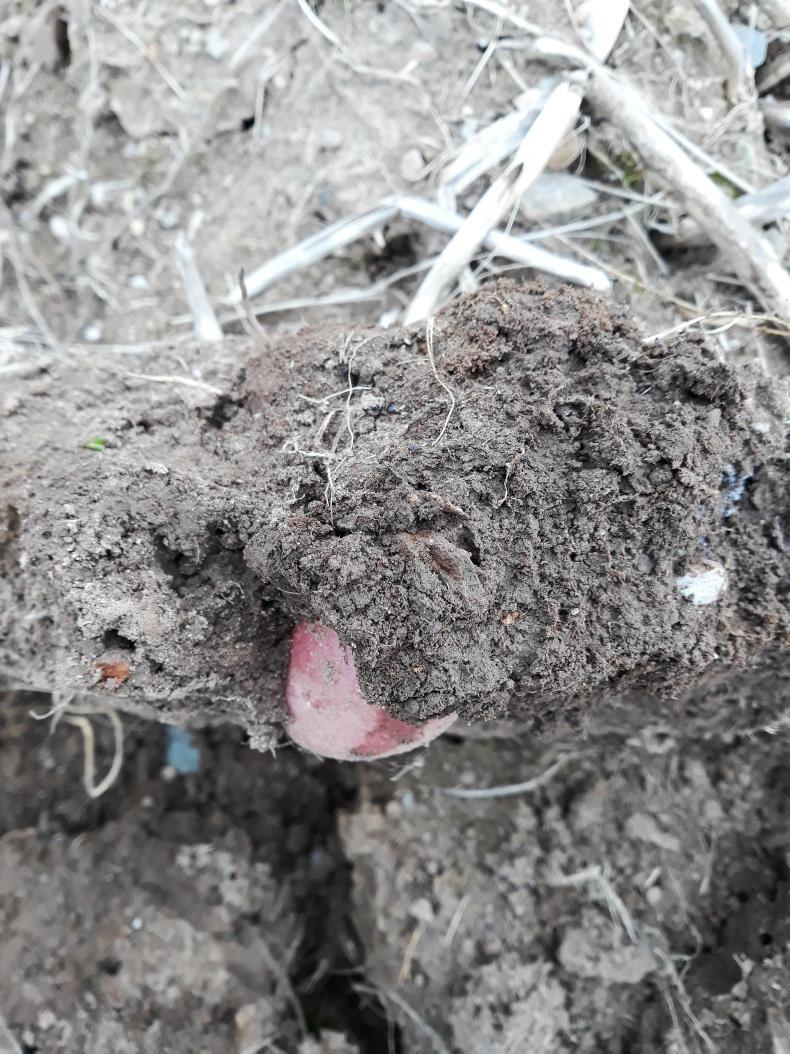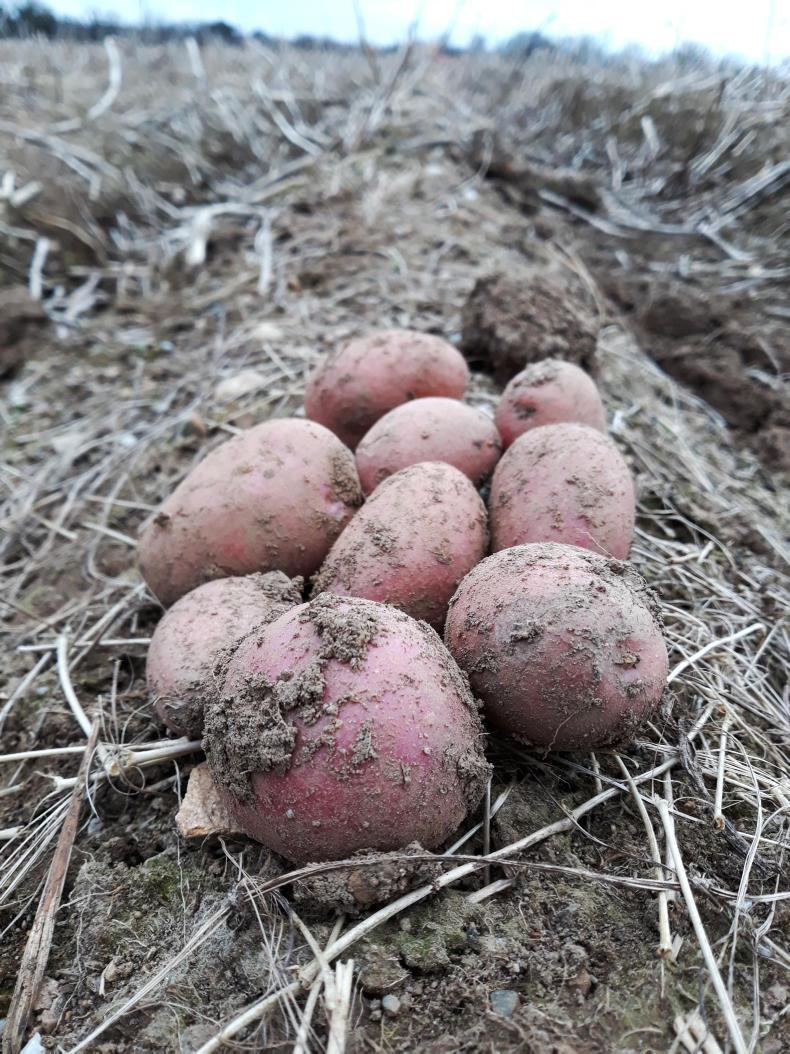After days of sustained sub-zero conditions, much of the ground around the country remains frozen. While many farmers used this to their advantage by catching up with late harvest jobs, ground work and early cultivations, potato farmers who still have crops in the ground have expressed concern.
The IFA’s latest stock survey estimates that between 800 and 1,000 acres of potatoes remain in the ground in the Republic of Ireland. The poor weather conditions during autumn 2017 meant that ground conditions were difficult throughout the entire potato harvest. In many cases, potatoes on heavier, wetter land could not be harvested and remain in the ground today.
There was a similar situation in Northern Ireland where last year farmers experienced one of the most challenging harvests in 30 years.
Last November, Ulster Farmers Union potato chair Robert Sibbett stated that in some cases, farmers had up to 10% of their potato crops left unharvested.
While there was some digging in parts of the country last week, progress has once again stopped with the onset of the Arctic weather. This has prompted concerns that the remaining potato crops may be at risk of frost damage.
Frost damage
Potatoes are notoriously frost-sensitive. While potato drills offer protection from light frosts, prolonged spells of sub-zero conditions will penetrate soil cover and can reach tubers which are close to the surface.

Fields which have no snow cover have borne the brunt of the low temperatures.Widespread frosts throughout the last week saw temperatures dropping to -10°C in places.
Where snowfall has accumulated in fields, this will act as a layer of natural insulation from frost and as a result, damage will be minimal. However, melting snow could lead to poor ground conditions.
Exposed drills will have felt the brunt of the cold weather and frost will have been penetrated the soil to depths of between 2in and 3in. This is deep enough to catch tubers close to the surface.
Freezing potato tubers result in the formation of ice crystals within the tissue. Once frozen tissue thaws, it generally discolours quickly from off-white to pink and red, and eventually to brown, grey or black. These tubers break down rapidly into a soft watery mass, leaving a chalky residue as the water evaporates.
Low-temperature injury
Some packers have also stated that low temperature injury may also be problem with potatoes which are still in the ground. A low-temperature injury consists of internal damage to the tuber caused by exposure to temperatures below or slightly above freezing.

Tubers which are in the top three inches of the drill are most at risk.Symptoms include a greyish discoloration, predominantly of the vascular tissue and results in the eventual death of the effected cells. The tuber itself doesn’t necessarily have to be frozen for this to occur.
The real issue associated with low temperature injury is that externally, affected potatoes usually appear to be of good quality but the damage cannot be assessed unless tubers are cut.
Potatoes can be bagged and on supermarket shelf’s before external signs begin to appear. This could lead to rejection of the product and heavy fines placed on the packer.
Concerns
In the past, when faced with similar circumstances markets would normally rally to compensate growers for loses incurred during bad harvests through higher prices due to shortages of supply.
However, this year supply has been plentiful and with low prices for lower-quality potatoes, some growers are assessing the viability of digging their remaining crop.
Read more
Weather stops field work once again
‘Potatoes are rotting in the field’
After days of sustained sub-zero conditions, much of the ground around the country remains frozen. While many farmers used this to their advantage by catching up with late harvest jobs, ground work and early cultivations, potato farmers who still have crops in the ground have expressed concern.
The IFA’s latest stock survey estimates that between 800 and 1,000 acres of potatoes remain in the ground in the Republic of Ireland. The poor weather conditions during autumn 2017 meant that ground conditions were difficult throughout the entire potato harvest. In many cases, potatoes on heavier, wetter land could not be harvested and remain in the ground today.
There was a similar situation in Northern Ireland where last year farmers experienced one of the most challenging harvests in 30 years.
Last November, Ulster Farmers Union potato chair Robert Sibbett stated that in some cases, farmers had up to 10% of their potato crops left unharvested.
While there was some digging in parts of the country last week, progress has once again stopped with the onset of the Arctic weather. This has prompted concerns that the remaining potato crops may be at risk of frost damage.
Frost damage
Potatoes are notoriously frost-sensitive. While potato drills offer protection from light frosts, prolonged spells of sub-zero conditions will penetrate soil cover and can reach tubers which are close to the surface.

Fields which have no snow cover have borne the brunt of the low temperatures.Widespread frosts throughout the last week saw temperatures dropping to -10°C in places.
Where snowfall has accumulated in fields, this will act as a layer of natural insulation from frost and as a result, damage will be minimal. However, melting snow could lead to poor ground conditions.
Exposed drills will have felt the brunt of the cold weather and frost will have been penetrated the soil to depths of between 2in and 3in. This is deep enough to catch tubers close to the surface.
Freezing potato tubers result in the formation of ice crystals within the tissue. Once frozen tissue thaws, it generally discolours quickly from off-white to pink and red, and eventually to brown, grey or black. These tubers break down rapidly into a soft watery mass, leaving a chalky residue as the water evaporates.
Low-temperature injury
Some packers have also stated that low temperature injury may also be problem with potatoes which are still in the ground. A low-temperature injury consists of internal damage to the tuber caused by exposure to temperatures below or slightly above freezing.

Tubers which are in the top three inches of the drill are most at risk.Symptoms include a greyish discoloration, predominantly of the vascular tissue and results in the eventual death of the effected cells. The tuber itself doesn’t necessarily have to be frozen for this to occur.
The real issue associated with low temperature injury is that externally, affected potatoes usually appear to be of good quality but the damage cannot be assessed unless tubers are cut.
Potatoes can be bagged and on supermarket shelf’s before external signs begin to appear. This could lead to rejection of the product and heavy fines placed on the packer.
Concerns
In the past, when faced with similar circumstances markets would normally rally to compensate growers for loses incurred during bad harvests through higher prices due to shortages of supply.
However, this year supply has been plentiful and with low prices for lower-quality potatoes, some growers are assessing the viability of digging their remaining crop.
Read more
Weather stops field work once again
‘Potatoes are rotting in the field’








 This is a subscriber-only article
This is a subscriber-only article












SHARING OPTIONS: